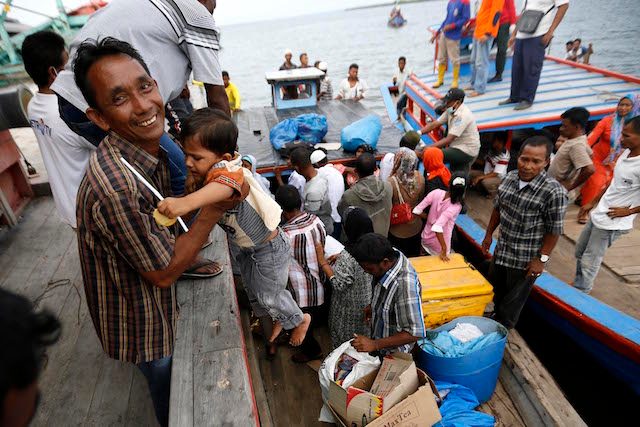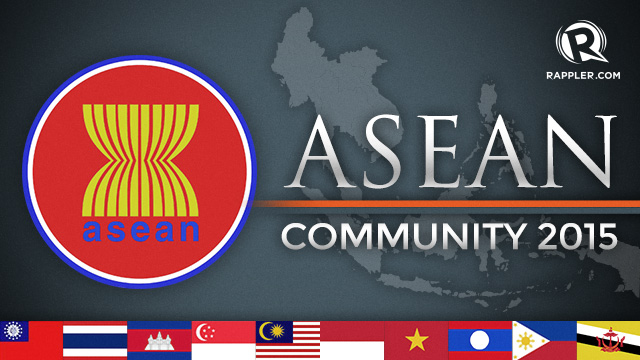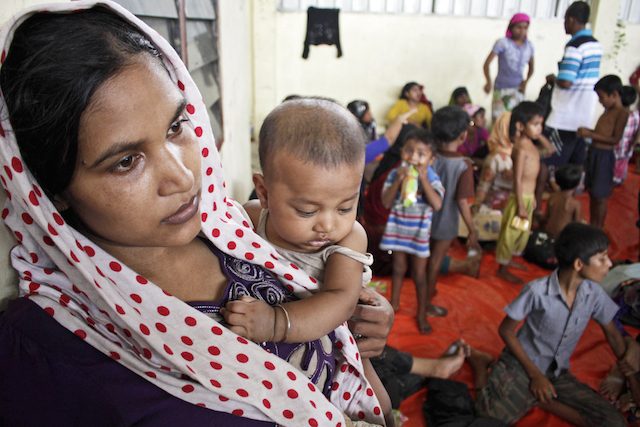SUMMARY
This is AI generated summarization, which may have errors. For context, always refer to the full article.
 In recent weeks, Malaysia – this year’s ASEAN chair – asked Myanmar to address internal problems that have been pushing minority Rohingyas to leave the country. In the ASEAN context, these were quite candid words directed to a fellow member country. (READ: Part 1: Rohingya crisis pushes ASEAN into unfamiliar waters)
In recent weeks, Malaysia – this year’s ASEAN chair – asked Myanmar to address internal problems that have been pushing minority Rohingyas to leave the country. In the ASEAN context, these were quite candid words directed to a fellow member country. (READ: Part 1: Rohingya crisis pushes ASEAN into unfamiliar waters)
ASEAN does not have a dispute settlement mandate, though it is often expected or assumed to have one. But whether formally or informally, quietly or in public, as a group or as individual nations concerned about matters in the “ASEAN family,” it has on some occasions come forth to try to manage ticklish issues.
The presence and role of ASEAN was key to getting humanitarian aid into Myanmar after Cyclone Nargis struck the nation in 2008, when distrust of external and western agencies and governments was high.
In 2013, Indonesia as ASEAN chair tried to get Thailand and Cambodia to address their conflict over the Preah Vihear temple. The ASEAN chair is not required to do this, but Indonesia did take some action because, as one ASEAN secretariat official said, “we are all in the same family, so let’s talk about it.”
On the Rohingyas, action by ASEAN members – not necessarily the organization as such – need not be done in full public view or in the traditional way, says Moe Thuzar, lead researcher for socio-cultural issues at the ASEAN Studies Center at the Institute of Southeast Asian Studies in Singapore.
“The situation does require a regional response, as it has a transboundary dimension; what has happened in one country has spilled over to other countries within knock-on effects in these countries,” she said in an interview. “But using the ASEAN framework does not necessary have to be a group of officials sitting around a table discussing semantics.
While this may sound “idealistic” since the Rohingya crisis has been simmering for decades, she says, “In a way we have to look how Nargis catalyzed new ways of working for ASEAN to bring humanitarian assistance to Myanmar; and also look beyond Nargis, building on what worked then, to find new ways of tackling multidimensional humanitarian crisis.”
Jerald Joseph, chairman of the civil-society network called the ASEAN People’s Forum 2015, put it bluntly: “ASEAN has to mature and grow up to be an adult. Non-interference in this instance runs counter to the charter calls for respect for international humanitarian and human rights norms.”
Domestic sensitivities
Working on the post-Nargis humanitarian response is, however, arguably less politically sensitive than dealing with the Rohingya issue. Likewise, it is linked to concerns that play out in different ways in ASEAN domestic constituencies, thus adding to its complexity.
For instance, “governments in Malaysia and Indonesia also have to ensure that their actions do not provoke reactions by the majority-Muslim population and their concern for fellow Muslims, so they will not want to prolong the crisis for too long,” said Rosalia Sciortino, a professor at Mahidol and Chulalongkorn universities in Bangkok who teaches courses on regional integration.
 On May 19, Muhammadiyah, Indonesia’s second largest Muslim organization, said the country must accept the “Rohingya Muslim refugees” because “they are stateless and Muslim.” After agreeing to take in the stranded Rohingya, Malaysia’s Prime Minister Najib Razak posted on Twitter that he had ordered search and rescue missions for the Rohingya boats because “we have to prevent loss of life.”
On May 19, Muhammadiyah, Indonesia’s second largest Muslim organization, said the country must accept the “Rohingya Muslim refugees” because “they are stateless and Muslim.” After agreeing to take in the stranded Rohingya, Malaysia’s Prime Minister Najib Razak posted on Twitter that he had ordered search and rescue missions for the Rohingya boats because “we have to prevent loss of life.”
For its part, Thailand is keen to show action on human smuggling and trafficking, especially after the recent discovery of mass graves of Rohingyas from camps near the Thai border with Malaysia. News reports cite several arrests. The country is still smarting from its downgrading in 2014 to a Tier 3 country in the annual US “Trafficking in Persons” report, due to the use of forced and bonded labor in the fishing industry.
Myanmar is coming under more pressure from its neighbors at a sensitive time, with a poll due later this year. Political parties and figures, including Aung San Suu Kyi, have been cautious in commenting on the Rohingyas, keen to keep voter support in the majority-Buddhist populace.
But on May 20, a spokesman for the opposition National League for Democracy party was quoted as telling The Independent newspaper that it is time to give the Rohingyas citizenship.
“The international community could put pressure on Myanmar to change their attitude and reconsider some of their enthusiasm for the ‘transition’ in Myanmar,” Sciortino said, asking if they would receive the Rohingyas when “conservative governments are increasingly closing venues for refugees.”
Australia has shut the door to Rohingya “boat people” while US officials have been quoted as saying the country would be willing take some in.
We are family?
Joseph argues that the end-2015 launch of the ASEAN Community – in the areas of politics and security, socio-cultural areas and economic – would be “meaningless” if ASEAN does not rise up to the challenge in its midst.

But “in any community or family environment, there are messy issues that require dealing with, despite different levels of comfort,” Moe pointed out. “The point to emphasize is to what extent is there a shared interest to tackle this, and how can regional consultations help respond to this shared interest.”
Myanmar calls the Rohingyas Bengalis and has denied them citizenship, leaving them stateless. There are a little over one million of them, and 300,000 are said to have already left the country, while others live in camps in Myanmar.
Thousands have taken dangerous journeys from the Bay of Bengal going south, stopping in Thailand before arriving in Malaysia. While this is not new, the “boat people” in the current crisis were abandoned by smugglers after a clampdown by Thai officials. News reports say more than 3,000 have been rescued in recent weeks – many by fishermen – or allowed to land so far.
The United Nations High Commissioner for Refugees (UNHCR) says 25,000 people have departed from the Bay of Bengal in “irregular maritime movements” in the first quarter of 2015. Refoulement, or pushing people back, has been taking place increasingly over the last 3 years, the UNHCR added, as countries become less friendly to asylum seekers, refugees, and persons of concern.
The one point where ASEAN countries like Indonesia, Malaysia and Thailand have had a common tack is in calling the “boat people” migrants, and not refugees, lest it bind them to taking them in.
“(But) they (Rohingyas) are stateless people cast out as refugees/asylum seekers,” explained Joseph. “ASEAN governments must accept these abandoned boat travelers into their shores as refugees.”

When Indonesia and Malaysia agreed on May 20 to give temporary shelter to the Rohingyas, their statement called them “irregular migrants still at sea.” The May 29 meeting called by Thailand on the issue is called the Special Meeting on Irregular Migration in the Indian Ocean.
“The different terms all point to the politicized nature of this issue, and how the different governments and stakeholders want to frame the situation,” observed the ASEAN Studies Center’s Moe Thuzar.
Indonesia, Malaysia, and Thailand are not parties to the 1951 Refugee Convention, which spells out state responsibilities toward refugees and bars refoulement or returning them to a country where they face danger of persecution.
Among the 10-nation ASEAN, only the Philippines and Cambodia are parties to that convention. The Philippines is the only ASEAN country that has signed the 1961 Convention on the Reduction of Statelessness. A few days before Malaysia agreed to give temporary shelter, a top official was quoted as saying the Rohingyas should go to Cambodia or the Philippines instead, because they are required to take in refugees as party to the refugee convention.
Rights campaigners have long been pressing other ASEAN countries to be part of the refugee convention, citing abuses that people suffer without official refugee status. Thailand has hosted people from Myanmar for decades, but does not afford them refugee status; the same with Malaysia for people from Myanmar and Sri Lanka, among others.
There might not be too much optimism for an ASEAN approach if one considers that population mobility is an area where it has been unable to forge a real policy on. If it has not addressed the reality of the millions of undocumented migrant workers in its midst and its members still deal with this bilaterally, how much more political will can ASEAN muster when it comes to the Rohingyas?
“We are talking here of refugees, not migrants, thus people who are escaping not only from poverty, but from terror,” said Sciortino.
In the days ahead, what ASEAN countries may take are “pragmatic baby steps forced by circumstances, not drastic ideological changes as the ASEAN modus operandi are quite ingrained,” she added.
But Moe believes otherwise: “The ASEAN ‘quiet diplomacy’ approach may still prove workable, as it emphasizes the consultative element. But we all have to be aware that because the issue is decades-long, and because there is a trust deficit, any response needs to take a long-term approach, and people need to continue working on it long after public attention has moved on to the next headline.” – Rappler.com
Johanna Son is a journalist and editor who follows regional affairs and has been based in Bangkok for 15 years. She is also director for IPS Asia-Pacific news agency.
Add a comment
How does this make you feel?
There are no comments yet. Add your comment to start the conversation.